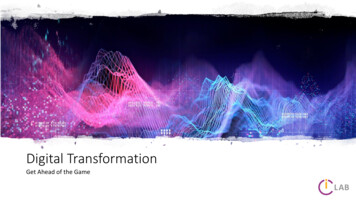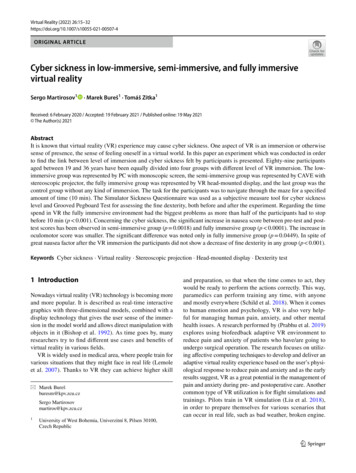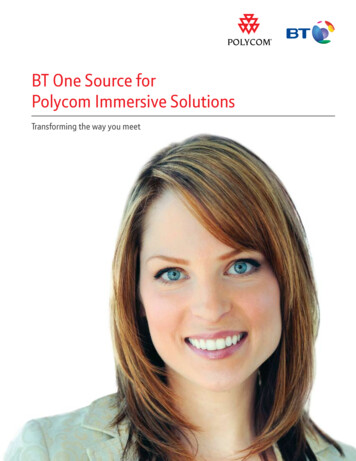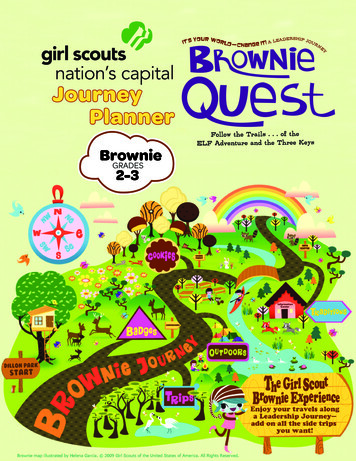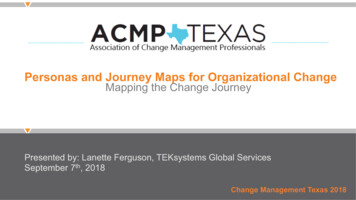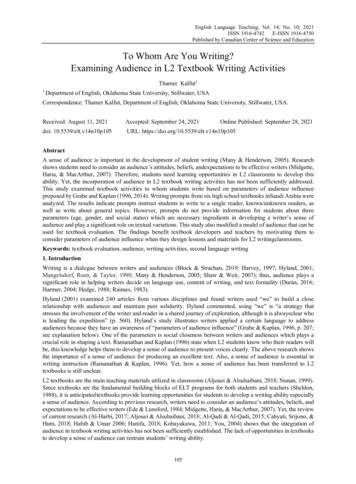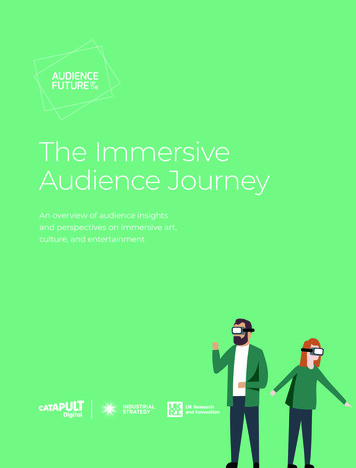
Transcription
The ImmersiveAudience JourneyAn overview of audience insightsand perspectives on immersive art,culture, and entertainment
This report is a result of researchconducted by Digital Catapult on behalfof UK Research and Innovation (UKRI),in collaboration with the Audience ofthe Future Demonstrator programme.UKRI’s Audience of the Future programme is fundingindustry-led consortia in the creative sector to createnew immersive experiences.The Industrial Strategy Challenge Fund bringstogether the UK’s world-leading research withbusiness to meet the major industrial and societalchallenges of our time. It provides funding andsupport to UK businesses and researchers, part ofthe government’s 4.7 billion increase in researchand development over the next 4 years. It plays acentral role in the Government’s modern IndustrialStrategy. It is run by UK Research and Innovation,which comprises the Research Councils, InnovateUK and Research England.The Immersive Audience Journey2
ContentsIntroduction: immersive productionsand the question of ‘audience’30Journey phase 0: segmenting immersive audiences30Highlights10Research questions and goals31Functions of audience segmentation11Methodology32Approaches to segmentation3413Immersive productions and audience researchImmersive audiences for museums, galleries,and live events14Immersive content is not part of everydaymedia content34Arts audiences35Museum audiences15Opportunities and challenges for audiencedevelopment36Immersive live events15Context defines immersive audiences37Media and entertainment audiences37Audiences in the creative process18The immersive audience journey38Audience role in relation to content19Immersive engagements as customer journeys38Audiences’ interaction styles19Customer journey mapping39Behavioural data24Challenges in studying audience journeys40From segmentation tactics to long-termrelationships24Opportunities for audience data inputs and outputs26Immersive audience journey: two perspectives42Journey phase 1: reaching audience awareness28Section summaries43Highlights44Market size45Social media and word-of- mouth strategies46Partnership strategies46Positioning immersive47Building community and anticipation48The audience engagement pre-launch49The audience engagement arc9The Immersive Audience Journey3
Contents51Journey phase 2: audience considerations74Summary and reflections52Highlights74Reflections on research questions53Imagined affordances fuel consumer consideration75Audiences will define the medium54Motivations for consuming art and entertainment7855The value of tourism studiesCurrent immersive audiences are shapingthe future57Audience technology acceptance57Willingness to pay80Tools for designing immersive audience journeys59The ‘country of origin’ effect in the UK59Decision factors within audience consideration84Footnotes, acknowledgements & about authors84Footnotes88Acknowledgements89About authors62Journey phase 3: evaluating audience experience63Highlights64Current evaluation challenges65Existing approaches and tools66Research opportunities69Journey phase 4: satisfaction and loyalty70Highlights70Expectation influences loyalty and advocacy71Audience retention goalsThe Immersive Audience Journey4
Foreword from UKRIWelcome to the ImmersiveAudience Journey reportThe UK is home to some of the world’s leading digital andcreative talent, and the experiences produced by projectsfunded by the Audience of the Future programme certainlyexemplify this excellence from large-scale immersiveprojects through to investment support and R&D intoproduction innovation.The Immersive Audience Journey report, supported by theAudience of the Future programme, explores if there reallyis an easily identifiable “immersive audience”, or whetherimmersive experiences appeal to audiences as part of analready established offering of contemporary art, cultureand entertainment.According to Digital Catapult and Immerse UK 2019Immersive Economy report,1 the UK is the largestimmersive market in Europe with a rapidly developingecosystem. Many of the key components to enable creatorsto achieve more ambitious creative visions at scale are nowmarket-ready. However, there is currently insufficientinsight into audiences, causing myriad challenges for theimmersive creative content sector.This report aims to support market growth by identifyingsources and methods of obtaining audience insights, andusing these to create user awareness and capture theimagination of future prospective audiences. Before theCovid-19 pandemic in 2020, one key finding was thataudiences are potentially reluctant to embrace immersivetechnology in the home, favouring location-basedexperiences as a way to dip their toe in the waters of thisnew technology. Whether the pandemic has changedaudience behaviour permanently is something thatfuture studies should address.The impact of COVID-19 coupled with continuingchallenges of raising investment and building sustainablebusinesses means that understanding these audiences isnow more critical than ever. By sharing the insights fromthis report, we hope to raise awareness of best practiceswithin the immersive community to help creators andproduction studios as they pivot their models.Immersive technology continues to shift audiencebehaviour from ‘viewing’ content to ‘experiencing’and ‘recommending’ it ranging from exciting e-Sportsexperiences live-streamed in virtual reality (VR) toeducational augmented reality (AR) applicationsdesigned for the whole family to enjoy.The higher levels of technology acceptance andutilisation prompted by this unprecedented time mayalso shine a light on immersive experiences that providetruly memorable moments with longer-term impact.This creates the potential for audiences to prioritiseimmersive experiences in their future selection of art,culture, and entertainment.Professor Andrew ChittyUKRI Challenge Director for theAudience of the Future and CreativeIndustries Clusters ChallengeThe Immersive Audience Journey5
Foreword from Digital CatapultThis report creates an importantnew framework for exploringdifferent audiences in differentmarket segments and how theybehave around immersive content.Four years ago, when Digital Catapult began its immersivecontent programme, we hoped to see a gradual increase inthe adoption of VR and AR in mass markets. We hadassumed with a combination of optimism and naivety thatthe leading hardware manufacturers and platform ownerssuch as Sony and Oculus (with Facebook fully behindthem), HTC and Microsoft would push aggressively toconsumer uptake and that within five years we could expectto see a thriving global market into which UK immersivecontent producers could actively sell.The market has not developed that way yet. Instead we seegradual industrial adoption of AR in areas such as productdesign and machine maintenance. We see slow butconsistent growth in the use of VR in training and skillsdevelopment. We see a hardcore games community forwhom some VR games continue to attract an audience.We see broadcasters, film studios and cultural institutionsexploring the use of VR/AR and MR experiences as ancillaryto their core products.Immersive content, it is clear, is not yet part of everydaymedia consumption. It is still something special, somethingextra, experimental, unformatted, still novel. So who are thenew audiences for these experiences? How might youreach and segment them? How do they respond?This report has been created in collaboration with UKRIas part of the Audience of the Future programme to makesense of who the emerging audiences consuming thisform of entertainment really are, how they experiencethese new technologies, and what it is to be entertainedin this new format.This report comes out under lockdown, a good time forreflection and it will hopefully remain relevant and indeedgrow in relevance as industry starts to open up again.The pandemic offered a fleeting prospect of acceleratingmarket adoption as global populations retreated to theirhomes but the lack of available hardware meant that noreal growth was possible. The general speed and ease withwhich people adopted video conferencing technologies forbusiness and social purposes did produce what some havecalled an accelerated level of disruption. Over a two monthperiod digital adoption occurred at a rate which might havebeen predicted over two years, an encouraging indicator asto how cultural barriers which can prevent adoption can beovercome unexpectedly fast.Although prominent corporate players may stumble from timeto time, immersive content as a form of entertainmentor for delivering public services, as a means of culturalexpression and a tool for industrial deployment continuesto gain recognition and is being increasingly adopted. Thisreport creates an important new framework for exploringdifferent audiences in different market segments and howthey behave around immersive content. It takes the notion ofthe audience journey as a critical tool for how to think aboutwhat is going on in different immersive environments withdiffering levels of interactivity and different goals. Harnessingaudience insights will be key in the successful production ofcompelling immersive content and applications.This report is a must read for anyone wanting toproduce enthralling immersive work. It will help builda better understanding of current and future audiences,how to attract them, retain them, and, importantly, howto grow them.Dr Jeremy SilverChief Executive Officer,Digital CatapultThe Immersive Audience Journey6
Executive summaryThis report explores the conceptof ‘audiences’ when applied toimmersive productions in thefields of art, culture, heritageand entertainment.The term ’immersive’ is used to refer to experiences whereaudiences are placed into an environment that they feelimmersed in, and where that environment responds to theirpresence. The technologies enabling immersiveexperiences range from virtual reality (VR) using a headsetand augmented reality (AR) applications on smartphones,to location-based entertainment, attractions and events.The research adopts the customer journey map approachas a structure for defining the different phases thataudiences go through. Across the Immersive AudienceJourney, key findings include:– The immersive audience is not a single cohort,and their motivations to engage with an immersiveproduction can differ wildly– Creators are not currently practising systematicaudience segmentation– Traditional forms of marketing do not communicatethe unique nature of immersive experiences, makingimmersive productions challenging to market– Expected levels of audience interaction can be difficultto convey, and a number of practitioners recommenddiverting first-time users away from heavy interactivity– Immersive producers should consider how to blendproduction activities into marketing and adopt holisticthinking around audience engagement– Technology acceptance - how audiences see theperceived value of an immersive dimension as anaddition to their existing leisure and entertainmenthabits - factors strongly into audience interest– Systematic user testing is part of any project for larger,more established organisations, whereas for smallerorganisations it is something that has a tendency to bedeprioritised or takes place too late in the process– Audience satisfaction contributes to the willingness tore-engage and the willingness to recommend, thereforeproducers should invest in these aspects of thecustomer journey beyond the immediate boundaries ofthe experience itself– The post-experience offering contributes to the lifetimecustomer and audience value: facilitating fandom andrecall through merchandising and memorabilia, andgenerating word-of-mouth recommendationA more focused understanding of the target audience willbe key to the success of immersive productions in thefuture. Success might not be qualified in terms of massivemainstream breakthroughs, but rather as morecomprehensive reach and engagement with viable nicheaudiences intensely interested in the work and large enoughto be commercially viable.The Immersive Audience Journey7
Introduction:immersiveproductionsand the questionof ‘audience’Contents10Research questions and goals11MethodologyThe Immersive Audience Journey8
Introduction: immersive productionsand the question of ‘audience’There is an increasing need tounderstand the audiences whoare engaging with immersiveexperiences within the arts,culture and entertainment.According to Digital Catapult and Immerse UK 2019Immersive Economy report, the UK is the largestimmersive market in Europe. The UK virtual reality marketalone is expected to grow from 118 million to 294million by 2023, and the UK has over 1,250 companiesthat generate over 50% of their revenue from consulting,services or products within the immersive domain. Nearly300 of these companies operate in the media and artssector, which is the focus of our research.Among academic researchers, ‘audience’ in thedigital age has been defined as follows:“The people who, in their capacityas social actors, are attending to,negotiating the meaning of, andsometimes participating in themultimodal processes initiated orcarried out by institutional media.” 2The need to study the nature of immersive audienceshas emerged as a result of the Audience of the FutureDemonstrator programme. For Demonstrators facingthe goal set by the programme of reaching an audienceof 100,000 for their productions, the lack of audienceinsight was seen as a challenge, especially whereimmersive technologies would function as an enablerbeyond distribution.3This report explores the concept of ‘audiences’ whenapplied to immersive productions in the fields of art,culture, heritage and entertainment. The term ’immersive’is used to refer to experiences where audiences areplaced into an environment that they feel immersed in,and where that environment responds to their presence.Such environments can be either completely fabricatedor a digitally enhanced version of physical reality.Immersive technologies have powerful capabilities forcreating interactive environments, and are increasinglybeing used to produce experiential content. In the contextof our research, the technologies enabling suchexperiences range from virtual reality (VR) usinga headset and augmented reality (AR) applicationson smartphones, to location-based entertainment,attractions and events. These include interactive theatreand installations that take advantage of immersivetechnologies, such as the use of projection in museums orgalleries, and haptic technologies that leverage the senseof touch. This type of immersive production tends toengage multiple senses and often involves moving aroundwithin a defined space or interacting with objects. At thetime of our research, Jeff Wayne’s The War of the Worlds:The Immersive Experience was running in London, and theDemonstrators in the UKRI Audience of the Futureprogramme were starting work on their large-scaleimmersive productions, to be exhibited in 2020.This report is intended to inform immersive practitionerswho are invested in bringing a production to audiencesin the UK, whether location-based or digitally distributed.It is also a starting point for future dialogues withacademics with a background in audience researchor other related disciplines, such as design research,who are interested in immersive technologies.The Immersive Audience Journey9
Introduction: immersive productions and the question of ‘audience’RESEARCH QUESTIONS AND GOALSThis report seeks to answer key research questionsby identifying emerging practices among producersand researchers:– What do immersive practitioners think about reaching,entertaining, and retaining audiences?– How can immersive audiences be studied in differentstages of the production process?– Is it useful to map the process of becoming a consumerof immersive productions, events, or applications usingservice and design thinking tools?– Can such mapping help to identify areas that areunderdeveloped and/or under-studied?The goal is to raise awareness of best practices within theimmersive community, and share these approaches so thatthey can be adopted on a more widespread basis by thoseorganisations growing the immersive culture and economy.The Demonstrators in the Audience of the Futureprogramme provided the backdrop for this study. TheseDemonstrator projects range from mobile applications formass audiences to highly localised experiences staged byworld-renowned institutions - such as the Natural HistoryMuseum and the Royal Shakespeare Company - and citieslike Bristol and Gateshead. UK-based immersive startupsoutside the programme are also building location-basedexperiences and digitally distributed VR and ARapplications in the hope of creating similarly recognisedglobal brands. A number of these innovators werecontacted as part of the research.On behalf of UKRI, Digital Catapult has heard frompractitioners who have run immersive productions, andlearned how they have brought audience considerationsinto their projects. However, for many practitioners thishas not been possible due to the unique nature and relativeimmaturity of the immersive market.The report also aims to support immersive growth byidentifying sources and methods of obtaining audienceinsights, and how to use them to create consumerawareness and capture the imagination of future prospectiveaudiences. Consideration needs to be given to the spectrumof user experience: from audience segmentation methods toaccessibility and ethical considerations; and from usercentred experience design to using data to analyse userbehaviour to improve retention and monetisation.The Immersive Audience Journey10
Introduction: immersive productions and the question of ‘audience’METHODOLOGYThis report is the result of interviews, roundtablediscussions and academic research reviews. Interviewswere held with more than twenty immersive experts withexperience either as a content creator or researcher.These interviews were structured around the customerjourney map, focusing on the insights that intervieweeshad gained from running immersive productions orstudying their audiences. For example, creators wereasked how they had leveraged audience insights for theirproduction, how they had gathered audience data, andhow they had promoted their work. When interviewingcreators, the focus was on how they had conceptualisedtheir audience members during the creative process, andwhether they had observed audiences engaging with theirwork. The focus for researcher interviews was on theirparticular research interests, methodologies, and findings.Aside from the interviews and roundtables, the researchspanned five months, during which informal conversationswere held with practitioners and researchers in events.4When close to finalising this report, the DemonstratorResearch Leads were convened at a seminar in orderto discuss and validate the findings.Finally, reviews of academic research were undertaken,looking into immersive and audience researchapproaches in general, and into related studies identifiedas having the potential to yield applicable premises andinsights. These included: studies of visitors to touristattractions and these studies’ relevance to location-basedimmersive audiences; technology acceptance models andhow they might explain audience attraction or aversion toimmersive productions; and design thinking case studies,for example, in museums. The results in the reportamalgamate data collected from all these sources.Interviewees came from within and outside theDemonstrators; they were identified through DigitalCatapult’s network and from UKRI’s other programmes,such as the Creative Clusters. While most intervieweeshad worked on immersive in the UK, international creatorsand researchers were also included in order to benchmarkwhat is happening in the UK against what is happening inimmersive overseas. To cast the net wide and reach asmany interviewees as possible in the UK, Digital Catapultalso issued an open call for two roundtables focused onthe subject of immersive audiences.The Immersive Audience Journey11
Immersiveproductions andaudience researchContents14Immersive content is not part ofeveryday media content15Opportunities and challengesfor audience development15Context defines immersive audiencesThe Immersive Audience Journey12
Immersive productions andaudience researchAlthough the initial motivationfor studying practices relating toimmersive audiences came fromthe Audience of the FutureDemonstrator programme,audience development in generalhas been high on the agendaof cultural institutions for the lastdecade. This has been due tochanges in the media landscape,such as the emergence of socialmedia and on-demand streamingservices, which have playeda major part in the increasingfragmentation of audiences.Audience development within cultural organisations hasalso been a theme for the European Commission, withthe premise that developing audiences leads to growth,diversification and deepening relationships with them.5These are all acute needs for the UK immersive ecosystem.For example, museums and heritage institutions are activelyseeking new audiences and ways to leverage the potentialof immersive technologies for more engaged, spatial, andembodied ways of learning, while making their public profilemore visible through innovation.6 Similarly, Arts CouncilEngland has identified that future audiences might becomemore demanding of traditional forms of arts and culture,as exposure to various other forms of entertainment hasgenerally increased.7 Immersive capability is expectedto contribute to resolving these issues.The expectation is that immersive content will seldom beexperienced at home, due to the cutting edge technologyand production setups required. Yet, to generate widespreadappeal, immersive experiences need to embody relevantthemes, franchises, and topics similar to the art, culture,and entertainment consumed at home. This means that theways in which people embrace new technologies, and howand why they attend and enjoy events, need to be taken intoaccount when studying immersive media consumption.The Immersive Audience Journey13
Immersive productions and audience researchIMMERSIVE CONTENT IS NOT PART OF EVERYDAYMEDIA CONTENTIt is tempting to seek points of convergence between whatis happening in the field of digital media audience researchand what is happening for immersive content. However,immersive content does not form part of mainstreamconsumption. VR headset sales are still mostly to earlyadopters, and AR games that have reached the mainstream(such as Pokemon Go) are more about mobility andgeolocation than AR and its immersive qualities. Locationbased immersive entertainment seems to appeal to anovelty-seeking audience, or a subsection of arts audiences.To accommodate this difference, some of the existingresearch that this study references originates from fieldssuch as event management, tourism studies, andexperience design. There are cases in which researchershave tackled the topic of future audiences using forwardlooking scenarios. However, the cases encountered in thisresearch have focused on technologies such as the internetof things (IoT), where researchers have seen developmentsin IoT as a future extension and amplification of currentmedia platforms.8While envisaging IoT playing a major role in futureaudiences’ media consumption may be valid, these studiesindicate that immersive technologies have not yet been aconsideration in the ways audience research is understoodwithin media and communication studies. Similarly, therehas been little room for the idea that immersivetechnologies will change the ways in which audiencesconsume media.However, this is a development that many of the immersivepractitioners interviewed are investing creative energy into:“We still firmly believe that the nextcomputing platform beyond thesmartphone will be some kind of headset- and we are trying to build for that future.”VR Startup FounderApplication and use of immersive technologies is alsothe future that influential tech companies believe in, asevidenced by Facebook CEO Mark Zuckerberg’s annualoutlook post for 2020:“While I expect phones to still be ourprimary devices through most of thisdecade, at some point in the 2020s,we will get breakthrough AR glassesthat will redefine our relationshipwith technology.”9Consequently, audience insights relating to immersivetechnologies have the potential to give producersan advantage when and if future media technologyplatforms and devices are built to deliver mainstreamimmersive content.The Immersive Audience Journey14
Immersive productions and audience researchOPPORTUNITIES AND CHALLENGES FORAUDIENCE DEVELOPMENTIn general, creators are inspired by the capability ofimmersive technologies to transform or augment reality:creating a digital layer of content to add to a physicallocation or creating an embodied experience of somethingthat cannot be experienced in the everyday - not just in thearts and entertainment, but also in heritage or educationalsettings, such as museums. Immersive has great potentialfor making abstract scientific concepts tangible,communicating scale, or creating re-enactments of historicalevents. There is evidence that immersive interaction withenvironments and objects can make them more memorable,reinforcing learning and overall impact. Heritage sites andmuseums exhibiting immersive productions can alsoencourage social and intergenerational visits, whilepresenting themselves as innovative, up-to-date institutions.However, existing immersive opportunities can bechallenging to realise, thanks to issues such as technologyacceptance and effectively communicating their nature.The challenges for immersive in the consumer space arecurrently greater than those relating to specific use casesin enterprise and business-to-business. Using immersivetechnologies does not necessarily create new revenuestreams for enterprise: the value is often found inimprovements to productivity, safety and efficiency.Within arts, culture and entertainment, immersiveproductions are expected to bring in additional or newprofit, making the need to understand and engageaudiences crucial.CONTEXT DEFINES IMMERSIVE AUDIENCES“Audiences don’t have any idea of what toexpect from an immersive experience.which could be anything from a verylight-touch promenade, where you justmove seats half-way through, to beingshut in a storage container and havingbuckets of water thrown at you.”AR Startup FounderIs there an identifiable immersive audience or do audiencesengaging with immersive events and products consist ofpeople who are drawn to them because of their generalinterest in contemporary art, culture, and entertainment?This is an important segmentation question, differentiatingbetween those who are interested in immersive for its ownsake, and those who are simply interested in the content,and happen to engage with the new medium as a result.This research indicates that it is likely that most playersof the most successful VR games, such as Beat Saber,do not constitute the same audience that would visit animmersive installation at, for example, the Saatchi Galleryin London. While these audiences might have mutualinterests and some overlap, they engage with the content indistinctly different locations and ways: home versus gallery;popular culture versus high culture; gamified exerciseversus art appreciation; recreation at homeversus leisure travel or social occasion.The Immersive Audience Journey15
Immersive productions and audience researchAudience overlaps are not always obvious, as LiminaImmersive found out in 2019 while operating a VR theatrewith curated content for a first-time, female-focusedaudience in Bristol. Their audience regarded the experienceas more akin to a museum or amusement fair visit thanto an arthouse cinema, which was what they initiallyassumed.10 Dotdotdot’s Jeff Wayne’s The War of the Worlds:The Immersive Experience, has been running in centralLondon since May 2019, and its audiences appear to havemore overlap with audiences for secret cinema11 than withthe early-adopter VR gamers who use headsets at home.These observations point to the importance of contextfor immersive experiences, and how location and socialdynamics are key factors in shaping audiences and thetypes of immersive experience that they will engage with.The immersive audience is not a single cohort, and theirmotivations to engage with an immersive productioncan differ wildly. How to conceptualise and study thesemotivations is addressed in the section of this reportcovering the ‘consideration’ phase of the audience journey.The Immersive Audience Journey16
The immersiveaudience journeyContents19Immersive engagements as customer journeys19Customer journey mapping24Challenges in studying audience journeys24Opportunities for audience data inputs and outputs26Immersive audience journey: two perspectives28Section summariesThe Immersive Audience Journey17
The immersive audience journeyWhen clarifying how immersiveexperiences relate to customerjourneys, the main challenge is howto capture the whole spectrum ofimmersive productions.Applying a customer journey perspective to immersiveproductions is based on two questions:– At which points along the journey, and how, areproducers employing immersive technologiesto enable the experience?– At which points along the journey, and how, areproducers conducting other audience engagementactivities to communicate what the experience isand how it can be accessed?SATISFACTIONAND LOYALT YIMMERSIONDECISIONCONSIDERATIONAWARENESSThe immersive audience journey is divided intofive phases: awareness, consideration, decision,immersion and loyalty.The immersive audience journeyThe Immersive Audience Journey18
The immersive audience journeyIMMERSIVE ENGAGEMENTS ASCU
19 Customer journey mapping 24 Challenges in studying audience journeys 24 Opportunities for audience data inputs and outputs 26 Immersive audience journey: two perspectives 28 Section summaries 30 Journey phase 0: segmenting immersive audiences . pdf. e si Digital Catapult



